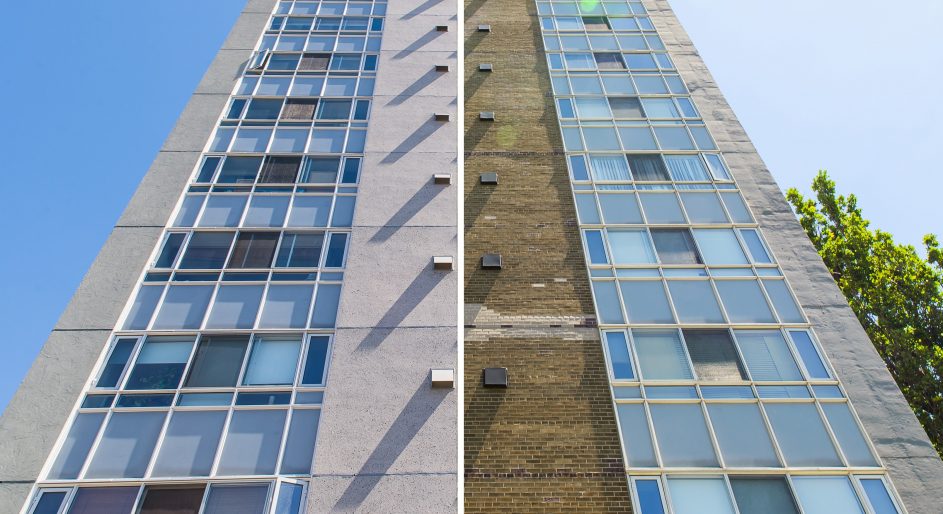Bringing older residential buildings up to code can be a daunting undertaking, and it’s common for certain key areas to be overlooked. While window, roof, and wall insulation replacements are accessible upgrades widely carried out, some areas—like airtightness—are becoming more urgent as radical building code changes loom.
Driven by local climate and environmental forces, as well as new federal and provincial policies, building codes are a set of rules written as the minimum requirements all structures must conform to in order to meet safety, efficiency, accessibility and other standards.
Presently, these codes are changing, both fundamentally and at a rapid pace, explains Sameer Hasham, Project Engineer with RJC Engineers. “The approach has shifted from a prescriptive design approach to a performance-based approach,” he says. “In B.C. for instance, the British Columbia Energy Step Code is now well-established for new buildings, which has been a great success. Overall targets for energy use intensities are becoming well defined with a clear roadmap outlined to meet the Net Zero-Ready targets by 2032. Radical code changes, and a shift in how we approach the built environment, will pave the pathway to Canada’s decarbonisation goal.”
By 2050, Hasham points out that Canada’s existing building stock will have significantly aged, and it will account for a considerable portion of emissions from buildings if not addressed in parallel to new construction.
“Governments at all levels have recognized the importance of tackling the existing building stock,” he says. “As such, a specific code for existing buildings will soon be implemented. The Pan Canadian Framework has committed to the development of a national model code for existing buildings by 2022, and this will have a profound impact on how we deal with the aging and inefficient building stock.”
Incentives & tax credits
Building upgrades and deep energy retrofits can come with a hefty price tag—a deterrent well-recognized at all government levels. As such, Hasham says part of the new framework will be to encourage improvements by offering incentives, grants, tax credits and other strategies to help offset costs and lessen the burden on the end user.
“Various programs are already well established, and provincial and federal governments are committing funds for climate action,” he says. “We expect these programs to get stronger, particularly as the model code for existing buildings prepares to be rolled out. I would not be surprised to hear funding programs announced in tandem with code changes in the near future.”
Improving airtightness
According to Hasham, one area that is often overlooked in terms of upgrades—and shouldn’t be—is airtightness. “Leaky buildings are inefficient and cost a lot to operate,” he says. “They are a significant source of heat loss, and they also present a risk for moisture-related issues like condensation build-up within walls.”
Air leaks are typically found around windows, doors, vents, and electrical outlets, which can easily be identified using tools for air leakage testing such as blower doors, thermal imaging and smoke tests—and once detected, they can be easily sealed.
Poorly detailed roof attics is another key area that impacts airtightness. Most owners tend to add insulation into their attic spaces for better thermal comfort as this is a simple and cost-effective solution, however, another option is to remove the older insulation first, which exposes the air barrier transition between the roof and the walls—a very common location of air leakage and heat loss.
When undertaking any roof work, Hasham advises that ducts and penetrations through the attics be sealed, along with sealing and fire caulking the fire separation walls inside attic spaces.
Windows and roofing
While windows and roofing replacement projects are common as they can be easily changed without significantly impacting the use of the building, Hasham does caution around the installment of renovation-style windows. “Although these are marketed as a cost-effective approach, they tend to rely on sealant and do not transition well with the surrounding envelope,” he says. “These can cause adverse effects in failure of the envelope, and do not effectively manage air leakage or moisture.”
In addition, when replacing your older windows with a thermally efficient upgrade, be sure to remove the surrounding cladding to expose the envelope component. “Good practice is to tie-in the new window assemblies to the envelope, and to maintain continuity of the moisture, vapour, thermal and air control layers,” he says.

The benefits of code compliance
Keeping up with code changes benefits everyone—from homeowners and building occupants, to our neighbourhoods and cities at large. By making the necessary upgrades to your existing residential building stock, you’ll be achieving the following:
- Increased occupant comfort
- Better indoor air quality and healthier interior environments
- Sound control
- Savings in operational costs (i.e. reduced heating bills.)
- A more desirable/marketable property
- Increased property value
It is expected that costs for electricity and gas will continue to increase over time. Add to this government policies, like carbon taxes, and costs over the next 10 to 15 years could continue to soar.
“In Canada, we are extremely fortunate to have access to plenty of natural resources. However, because of this, it’s easy to take them for granted,” Hasham warns. “We have to recognize that we must adapt to the challenges of the environment—and that means continuing to improve our buildings and keeping up with codes changes. For instance, with the International Energy Agency recommending the phasing out fossil fuel boilers by 2025, building owners anticipate this now.”
For more information, visit www.rjc.ca or contact Sameer Hasham





